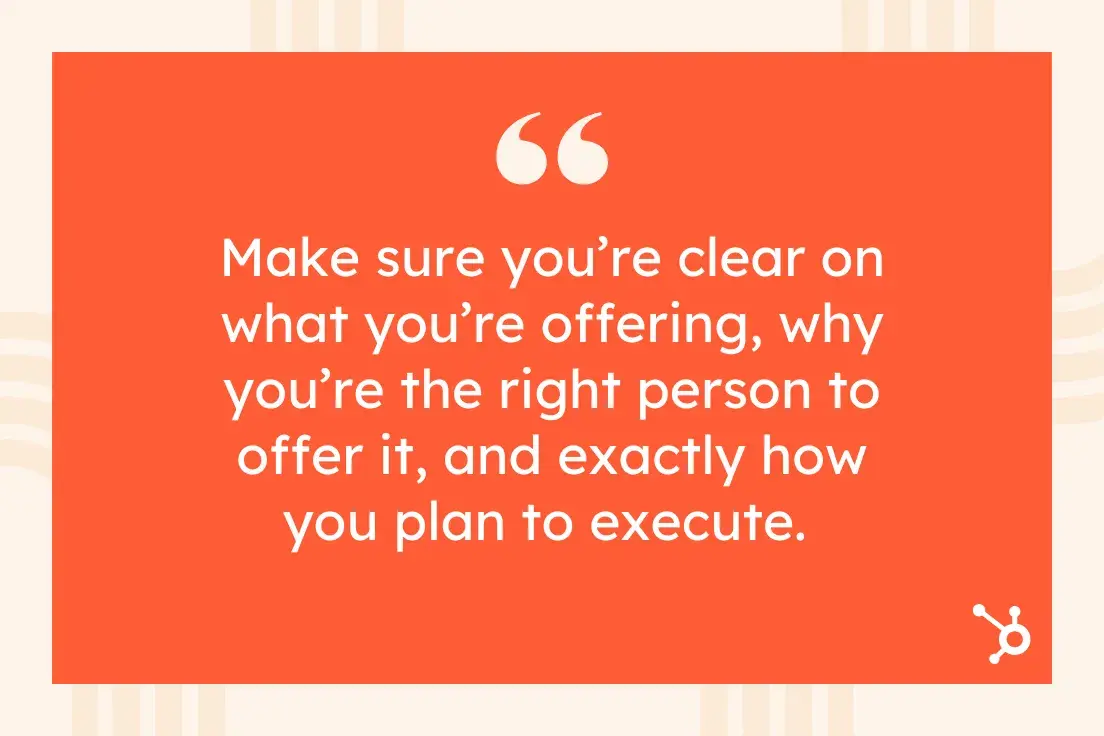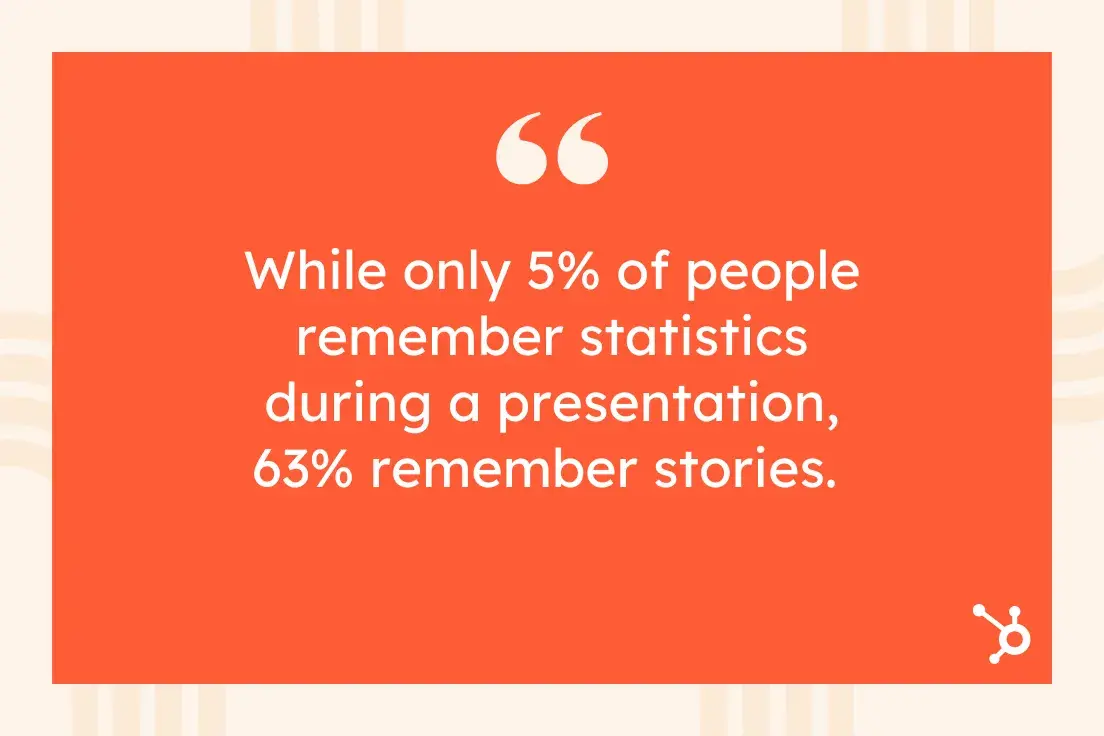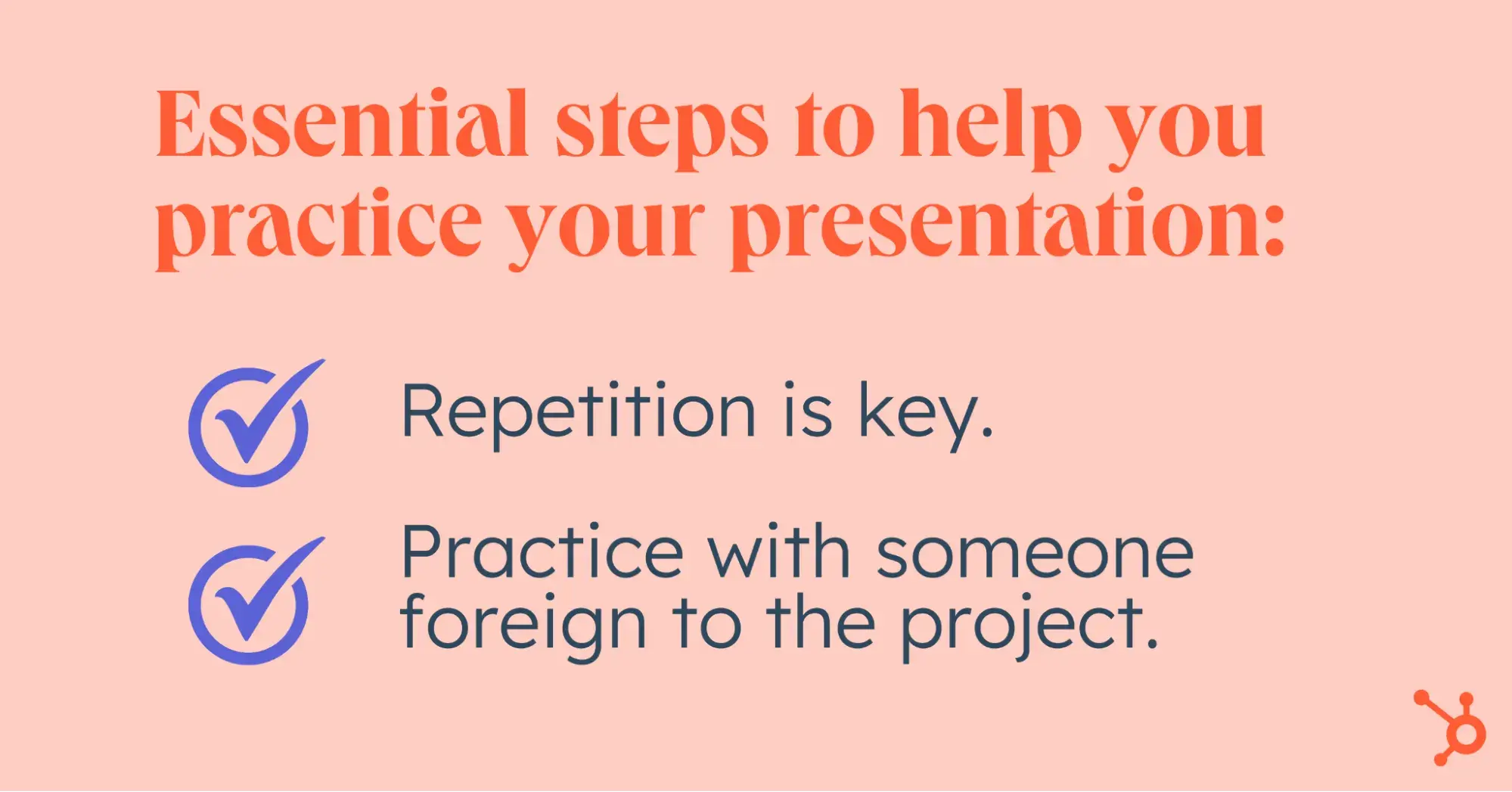Table of Contents
- What is a sales presentation?
- Best Practices for Planning a Sales Presentation
- Essential Steps to Help You Practice Your Presentation
- Tips for Delivering Your Sales Presentations
What is a sales presentation?
Think of a sales presentation as the ultimate pitching opportunity. It’s your chance to prove to your potential customer that your service or product is worthy of investment. It should include granular detail around the specific problem you’re aiming to solve, often with the support of visuals, case studies, and other relevant data.
Also, a sales presentation isn’t complete without a value proposition: Make sure you’re clear on what you’re offering, why you’re the right person to offer it, and exactly how you plan to execute.

Best Practices for Planning a Sales Presentation
1. Study your potential client and the industry.
I know internet stalking isn’t typically condoned, but when you’re planning your sales presentation, a deep level of research is crucial.
“The research step is really, really important, because then [the customer] is going to be like, ‘Hey, this person knows me,’” says Spencer. Your prospective client also wants to see that you have an understanding of the respective industry as a whole.
In addition to knowing the ins and outs of their company’s leadership and employees, “get acquainted with educating yourself about current trends, recent news, and your company’s competitors,” adds Erica Franklin, founder of EVF Consulting and global director of sales for Sistas In Sales.
2. Tell a story.
“Storytelling is winning,” says Franklin. While only 5% of people remember statistics during a presentation, 63% remember stories.
One of the best ways to storytell in a presentation is to incorporate case studies and real-world examples — especially ones that involve use of your product.
“I enjoy seeing presentations from companies that use their own products to convince customers to purchase those same products, like Monday.com and Gong.io,” says Franklin. “They are literally able to show you repeatedly why their products are successful.”
Storytelling is also what helped Franklin land a repeat client who was mulling over whether or not to renew the service. “Instead of accepting their hesitation, I crafted a renewal and upsell proposal that (I believe) shifted their perspective — not just on the current products but also on the future possibilities,” says Franklin.
She did this by showcasing the success of partnership via strategic storytelling and hypothetically presenting what growth would look like if they remained a customer. “They ended up not only renewing but also expanding their partnership,” shares Franklin.

3. Do the leg work — if you can.
Especially if your budget is tight, Spencer suggests putting together the presentation yourself rather than paying someone else to do it, and better allocate those funds to serve a business need elsewhere. It’s also how you get closest to the material you’ll be presenting.
Consider free resources from platforms like Canva, Keynote, Google Slides, and PowerPoint, many of which offer customizable templates.
AI, when used responsibly, can also be a help reviewing and formatting aid. Gamma is a new AI-powered platform on the market that I think is worth testing out.
4. Don’t go too text-heavy.
Forty percent of people prefer non-written visual forms of communication, so charts, graphics and other imagery are ideal.
Videos are even better. Plus, the more copy you add to your slides, the more inclined you’re going to be to read directly from the presentation. Text can be a crutch. Visuals are more of a guide. Likewise, “the more people are trying to read, the less they're listening,” says Spencer.
Another benefit of non-wordy slides is that they also make for a more concise presentation. When it comes to ideal length, Franklin says, “Depending on the product, I would say 20-30 minutes, leaving a few minutes for discussion, so 45 minutes max.”
5. Remove the excess.
Another rule of thumb? Each slide should convey exactly one point, says Spencer. That way you’re staying on track and keeping the customer engaged.
He suggests thinking of it like this: “What are the chapters in my story?” Each slide should be a “chapter.” You don’t want to muddle your chapters with excess, so take note of any information that’s not pertinent. If it’s not adding to the story, it probably doesn’t need to be included. If it must stay, include it as an add-on or reference point, like a book’s appendix or bibliography, that you don’t necessarily need to present.
Essential Steps to Help You Practice Your Presentation
1. Repetition is key.
The more you practice, the more nuances you’re able to consider — and that will make your presentation more interesting.
Repeated practice will also prepare you to be unfazed by any curve balls thrown at you the day of. The more you know your stuff, the less you’ll need to rely on a script. You’re able to deliver a more natural presentation, and I think it makes you more confident when you need to improvise as well.
2. Practice with someone foreign to the project
When you’re the closest to the concept, it’s easy to miss what requires more explanation. Try practicing on someone who has zero or very minimal knowledge of what’s being presented. This was, you can ensure your pitch is clear and thorough no matter who’s on the receiving end.
“You always want to assume that the person you‘re presenting to doesn’t have the level of detail that you have,” says Spencer. “And that they’re not an expert, because often they're not.”

Tips for Delivering Your Sales Presentations
1. Approach it like a conversation.
A sales presentation doesn’t have to feel like that boring lecture every student dreaded attending. Your client wants to learn, but they also want to feel included and engaged.
“Sales presentations have become much more conversational and less scripted or tied to a specific selling process,” says Franklin.
“While selling methodologies are great, sometimes just having real conversations about what is going on and what is needed wins. Trust-building is the key to closing deals.”
Building trust also means approaching the presentations like there’s an already-established partnership. Successful sales reps are 10 times more likely to use collaborative words like “us,” “we,” and “our.”
2. Allow the customer to speak.
Part of engaging your customer means allowing them to participate. Encouraging them to weigh in on the conversation positions you to address anything you may have missed, and you can sometimes drive your point home even further.
Franklin suggests asking your potential client open-ended questions like, “What does success look like for you?” or “What other products have you used in the market to address your pain points?”
3. Make sure your potential customer has a copy of the deck.
While the hope is that your presentation is clear — and that your prospective customer is taking notes — it’s important that they have reference points to refer back to later while deliberating.
“Presentations (even shorter versions) are helpful to your contacts after the meeting as they usually need something tangible and concise to help them sell internally,” says Franklin.
Send them an email with your slides before or after the meeting.
4. Wrap up with clarity around numbers and next steps.
Numbers are important. Always be clear on what yours are.
By the end of the presentation, your client should know exactly what you’re asking for and what the next steps are, should they choose to move forward.
Spencer says it’s important to be confident in the number you're presenting. You should have already done your homework, so “don’t negotiate against yourself,” he says, and be sure to give your potential client room to think.
Equally as important, he adds: “Remember that you’re going to hear no.” Sometimes, it’s a firm no (which happens to the best of us); sometimes, that “no” means not right now, or not in this way. After all, 83% of potential clients won’t initiate a sale for 3-12 months.
“If they cannot buy everything right now, make a long-term plan,” says Franklin. Sometimes it’s about playing the relationship game.
Ready To Present
While sales presentations generally aren’t generally a rep’s favorite part of the job, the best sales reps know that, when done right, sales presentations are a high-earning skill.
After I spent time talking with experts for this post and reviewing their tips and techniques, the one that stands out the most for me is: practice. It might not prepare you for every scenario, but it’ll prepare you for most of them. Best of all, you’ll be confident in your talking points — and your product. There’s no better way to go into a sales presentation.
Sales Presentation



![12 Best Sales Presentations To Inspire Your Sales Deck [+ 5 Tips]](https://53.fs1.hubspotusercontent-na1.net/hubfs/53/sales-deck-1-20241016-748271.webp)
.png)

.jpg)
![How to Make a Business Presentation in 7 Easy Steps [Free Business Presentation Templates]](https://53.fs1.hubspotusercontent-na1.net/hubfs/53/how-to-make-a-business-presentation.jpg)


